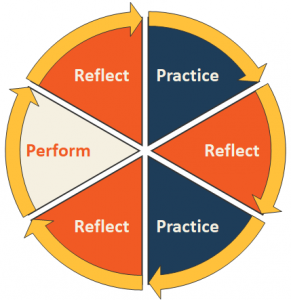Make the Most Effective Use of Your Training Log
Do you keep a training log?
If you are an endurance athlete, my guess is you will answer “yes”, and if you play a ball or stick sport, I am guessing your answer will be along the lines of “I keep track of my stats” and or “I have a weight training log”. I have two observations on these answers. First, tracking your stats or a strength training log is good, but does not allow you to critically reflect on practice and performances. Second, I would say that the vast majority of us keep inadequate training logs, or training logs that are actually detrimental to our growth and development as an athlete and competitor. In this post we will briefly look at two valuable skills: how to use your training log more effectively; how your training log is currently inhibiting your growth and development.
How do you use a training log incorrectly? First, filling out your log should not be seen as a chore, or as something annoying that your coach makes you do. You should be excited to fill in this log because this is where you solidify the lessons learned in training and competition.
During training and competition, you should be responding to what is happening around you; this is not the time to carefully reflect on the major changes you need to make, but instead on the subtle adjustments that need to be made in response to the competition environment. When you have the time, carefully reflect on what occurred during practice and competitions by: assessing how well you did; what did not go well; where you need to make the changes for your next practice/training session. Make the adjustments you identified in your reflections; reflect on how these changes went and identify additional areas of strength and weakness. REPEAT! REPEAT! REPEAT!

A quick aside on making these bigger adjustments. Notice how I said to make the changes for the next practice/training session? Hopefully, you did because you should NEVER make big changes before a competition.
Another way that we misuse training logs deals with the data we collect after a training session or performance. For most of us, we record basic statistics – average pace per mile, wattage output, batting average, shooting percentage, goal save %, number of digs, etc., etc. – which provides us with useful information, but there is no analysis of these metrics. Looking only at these metrics is like randomly throwing ingredients into a pot to make a soup. I love apples, chicken, jellybeans, beets, root beer, and mushrooms, but these ingredients would make a disgusting chicken soup. You need to put the raw data into context and place them along the continuum of development.
Training logs will be detrimental to growth and development if it becomes a consistent reminder of our failure to achieve perfection. When we reflect on a performance there is a tendency to identify only the negatives. What went wrong? Where did I fall short of my goal(s)? Why am I not getting better? Therefore, it is ESPECIALLY important to properly learn how to utilize a training log in order to affect a positive change on your journey to personal excellence. By insisting on perfection, we ignore everything that WENT WELL! If your team goes 15 and 10 for the season, you did not have a perfect record, right? However, my guess is you would be pretty dismayed if Coach came in and said, “team, we went 15 and 10 this season, which isn’t perfect, so I’ve decided to completely overhaul our training, offense, defense, preparation, and philosophy. Everything you learned last year, completely forget it as we weren’t perfect.” Just a hunch, but I would hazard a guess that the team will take a dramatic step backwards next season. While you can recognize the ridiculous statements from the coach above, can you recognize the ridiculous statements when you make them? By not adopting a developmental mindset that celebrates growth, you are doomed to fall into the cyclical pattern of demanding perfection, coming up short, completely overhauling your training or making no changes, and then demanding perfection all over again.
The training log is one of the most powerful tools an athlete/performer can use to help them in their journey of personal excellence. Unfortunately, training logs are often misused or not used at all. Self-reflection is a challenging undertaking, which requires a lot of courage to do frequently and comprehensively. However, when mastered, training logs can build robust self-esteem, increase self-confidence, develop self-efficacy (your belief that you can overcome setbacks/unexpected challenges), and develop a constructive relationship with failure.
Some Training Log Tips:
Always identify how you improved each day
Believe you can make the changes that need to be made
Understand your strengths and weaknesses
Ask for help when needed and provide help to those in need
References
Orlick, T. (2016). In pursuit of excellence: How to win in sport and life through mental training. Champaign, IL: Human Kinetics.
Ravizza, K, & Hanson, T. (2016). HeadsUp baseball 2.0: 5 skills for competing one pitch at a time. Tampa, FL: Hanson House.
Rotella, B. (2015). How champions think in sports and life. New York, NY: Simon & Schuster.